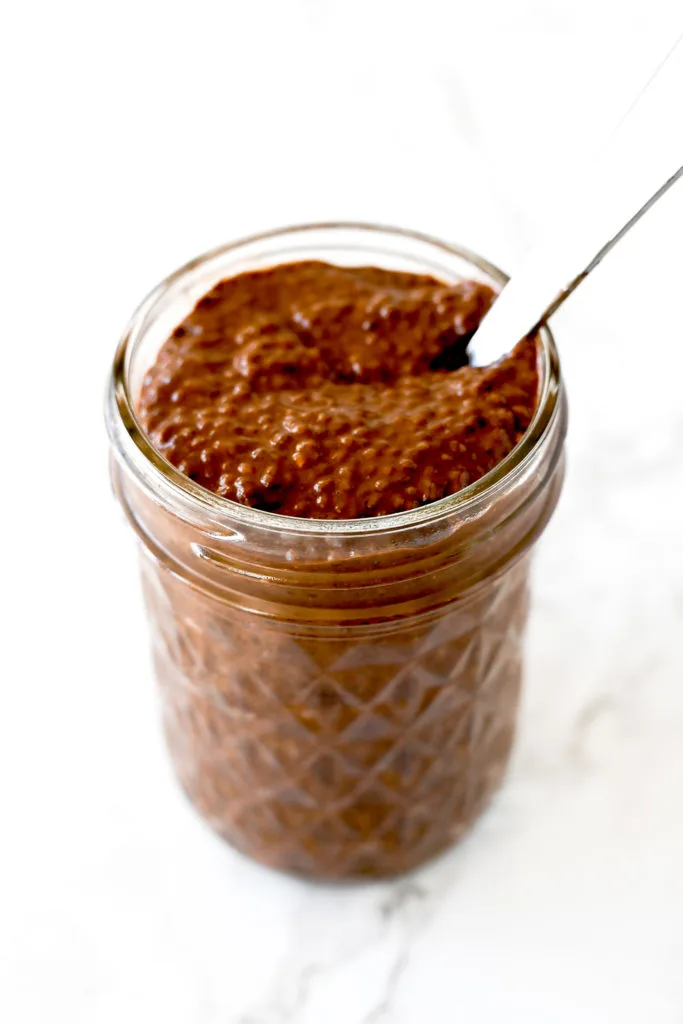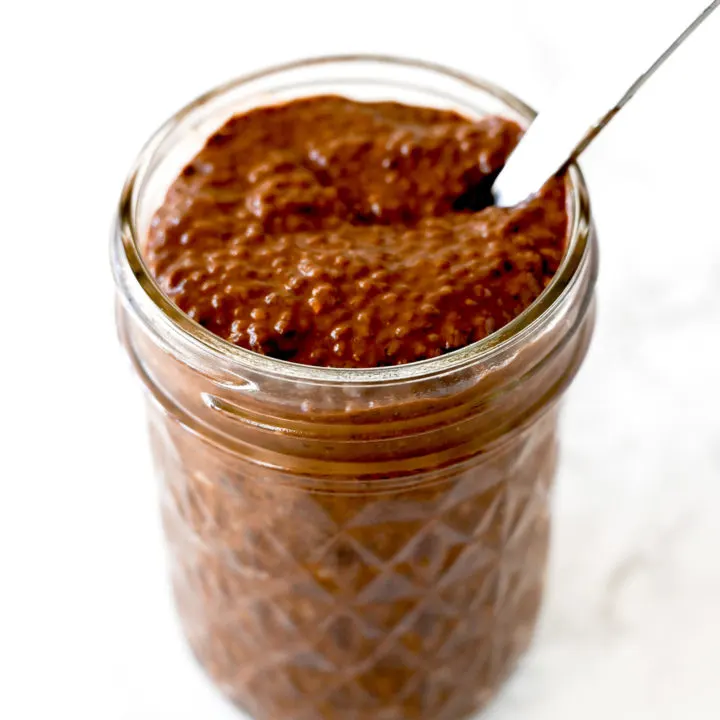This chocolate chia pudding with coconut milk is a rich, creamy, and delicious healthy breakfast, snack, or dessert. Top with your favorite fresh or dried fruit, nuts, or shredded coconut.

If you've never had chocolate chia pudding, it's kind of like eating chocolate pudding with tapioca in it. It can be eaten as a breakfast, a dessert, and, of course, a snack.
Chia seeds were a staple in the ancient Aztec and Mayan diets, and have been touted for their health benefits for centuries. In fact, “chia” is the ancient Mayan word for “strength.”
It seems only fitting that cocoa be added to this pudding, since cocoa was such an important food to the Aztecs as well.
Technically, there are many ways you can add chia seeds to your diet, but this chocolate chia pudding with coconut milk is one of my favorites.
The seeds are absorbing up to 12 times their weight in liquid when soaked and developing a coating that gives chia-based foods and beverages a distinctive gel texture.
I find this pudding so wonderfully rich that sometimes all I need is a bite or two to satisfy my chocolate craving or sweet tooth. Of course, regular chia pudding with coconut milk is always nice too.
One of the things I love about it is that you can make it ahead of time.
I do meal prep for the week on Sundays, and little jars of chia pudding are so easy to make and quick to grab. Best of all, it will keep in the fridge for a week.
You can mix things up by topping the pudding with fresh or dried fruit, nuts, shredded coconut, granola, and more.
Cocoa
Cocoa adds a rich chocolate flavor and a nice brown color to recipes. It also helps balance sweetness in recipes, adds moisture to baked goods, and can be used to decorate food.
It's used to make recipes like brownies, chocolate cake, chocolate sauce, chocolate cookies, chocolate muffins, and chocolate cupcakes. Cocoa can also be found in surprising places like cinnamon babka (just for the purpose of coloring) and savory dishes, such as chili and mole sauces.
The color can vary depending on the type of cocoa used. Natural cocoa powder tends to create a lighter color, while Dutch-processed cocoa results in a darker one.
Cocoa also adds moisture to recipes, giving baked goods a softer and tenderer texture.
Also, when combined with baking soda, cocoa's acidity activates the leavening agent, contributing to the rise and lightness of baked goods.
Furthermore, cocoa is often used for decorative purposes. It is dusted on top of cakes, used as a coating for truffles, sprinkled over whipped cream, and to create a dusted effect for plated desserts.
WHICH TYPE OF COCOA TO USE
When a recipe calls for cocoa, always use unsweetened cocoa powder, unless specified otherwise.
This allows you to have better control of the sweetness of what you’re making.
There are three basic forms of unsweetened cocoa powder: natural cocoa powder, dutch-processed cocoa power, and raw cocoa powder.
NATURAL COCOA POWDER
Natural cocoa powder comes from cocoa beans that are fermented, roasted, processed at a higher heat, and milled into a powder.
It’s bitter with a very strong and concentrated chocolate flavor.
This cocoa powder is acidic and is often used in recipes calling for baking soda because the two react with each other to allow your baked good to rise.
This is most commonly used, and should be used, in recipes that simply say "cocoa powder."
DUTCH-PROCESSED COCOA POWDER
Dutch-processed cocoa powder starts with cocoa beans that have been washed in potassium carbonate, which neutralizes their acidity.
Since Dutch-processed cocoa powder is neutral, it does not react with baking soda.
When baking, Dutch-processed cocoa is often paired with baking powder.
Dutch-processed cocoa powder can also be used in place of natural cocoa powder in recipes that don’t require leavening.
These include sauces, hot cocoa, frostings, ice cream, pudding, etc.
If you only have Dutch-processed cocoa powder on hand, you can substitute it for neutral cocoa powder.
Just make sure to add ⅛ teaspoon of cream of tartar, white vinegar, or lemon juice for every 3 tablespoons of cocoa powder called for in the recipe.
RAW CACAO POWDER
Raw cacao powder is different from natural and Dutch-processed unsweetened cocoa powder.
It's pure powder from the cacao bean and isn't nearly as processed as either natural or Dutch-processed.
Cocoa is processed at high heat, which destroys much of the nutritional benefits of the cacao seed.
Also, cocoa powder is often alkalized during processing to reduce acidity. The result is a product that’s less bitter and more soluble when added to liquids.
Cacao powder, on the other hand, is made of fermented - not roasted - seeds that are processed at low temperatures and then milled into a powder, ensuring that its nutritional benefits and its bitter flavor are preserved.
You can use raw cacao powder in recipes that don’t specify Dutch-processed cocoa powder, however it is best not to try to.
Compared to cocoa powder, cacao powder has a stronger flavor, it is not as absorbent as cocoa powder, and it is more acidic, so it will react differently with baking soda.
Sweetened Cocoa
Sweetened cocoa contains sugar and is suitable as a hot chocolate mix, but not suitable for recipes.
What's the difference between cocoa powder and cacao powder?
Cocoa powder is made by roasting cacao beans and processing them at high heat.
Cacao powder is made by cold-pressing unroasted cacao beans. It's often considered more "raw" and retains more nutrients.
Both can be used interchangeably in recipes.
Can I use Dutch-processed cocoa instead of natural cocoa?
Yes, but it can affect the acidity and leavening in the recipe. Adjustments may be needed for baking powder or baking soda.
To do this, simply add ⅛ teaspoon of cream of tartar, white vinegar, or lemon juice for every 3 tablespoons of cocoa powder called for in the recipe.
Can I use sweetened cocoa mix instead of unsweetened cocoa in baking?
No, because sweetened cocoa mix contains sugar. The added sugar can alter the sweetness and moisture of the recipe.
How to substitute cocoa powder for melted chocolate in recipes
Natural cocoa powder can be substituted for unsweetened baking chocolate by using 3 tablespoons of cocoa powder and 1 tablespoon of oil for every ounce of unsweetened baking chocolate.
How do I prevent lumps when using cocoa in recipes?
Sift the cocoa into the bowl to remove lumps.
How to Store Cocoa
Store cocoa in an airtight container and keep in a cool, dark place to prevent moisture absorption and maintain flavor.
Types of Vanilla
Vanilla comes from a pod commonly known as a “vanilla bean”, which comes from the vanilla orchids.
Vanilla pods have been used for flavoring since the Aztecs and was introduced to Europe by a Spanish conquistador, along with cocoa.
Vanilla Extract
Vanilla extract is created by soaking vanilla beans in alcohol for some time. This is the most commonly used type of vanilla.
Vanilla Sugar
Vanilla sugar is common in Europe and some parts of the Middle East, like Israel.
It is made from vanilla beans sitting in sugar, vanilla bean powder mixed with sugar, or sugar mixed with vanilla extract.
In some countries, like Italy, you can also find vanilla powdered sugar, which is used for confections.
Vanilla Paste
Vanilla paste is generally a specialty item. It is a thick paste that contains a blend of the scraped-out vanilla pod seeds and vanilla extract.
You can use it as you do vanilla extract and it will leave flakes of vanilla bean like you see in vanilla bean ice cream.
Imitation Vanilla
Imitation Vanilla, otherwise known as artificial vanilla or vanilla essence, is made from synthetic vanilla.
This is the compound that naturally occurs in vanilla beans and gives it its flavor.
Can I use imitation vanilla?
Many will tell you that you should use high quality vanilla, just like they say you should use the best cocoa.
However, most of us will probably not be willing to pay the hefty price that comes with exceptionally high-quality ingredients.
Overall, vanilla is very expensive, so the extract is as well.
So, if you’re not going to get regular quality vanilla extract, you might as well use imitation vanilla.
Can vanilla extract be used as a substitute for vanilla beans?
Yes, vanilla extract can be used as a substitute for vanilla beans. Use about 1 teaspoon of vanilla extract for each inch of vanilla bean.
How to Store Vanilla
Pure vanilla extract and other vanilla products should be kept away from heat and light, and should be stored in an airtight container in a cool, dark place.
Does chia pudding contain dairy?
Some variations do, but it isn't necessary since you can use a dairy free milk. This recipe uses coconut milk.
Chocolate Chia Pudding with Coconut Milk

This chocolate chia pudding with coconut milk is a rich, creamy, and delicious healthy breakfast, snack, or dessert. Top with your favorite fresh or dried fruit, nuts, or shredded coconut.
Ingredients
- 1 tablespoon cocoa powered
- 2 tablespoons chia seeds
- 1 tablespoon honey or maple syrup
- ¼ teaspoon ground cinnamon
- ¼ teaspoon vanilla extract
- ½ cup light coconut milk
Instructions
1. To a jar, add cacao powder, chia seeds, ground cinnamon, honey or maple syrup, and vanilla. Mix to combine.
2. Add a little coconut milk at a time and mix until a paste forms. Next, add remaining coconut milk and mix until smooth.
3. Let sit for 2-3 minutes. Then, mix again to make sure the chia seeds are evenly spread and not clumped at the bottom.
4. Cover and refrigerate overnight, or at least 3-5 hours.
5. Serve chilled with desired toppings.
Nutrition Information:
Yield:
1Serving Size:
1Amount Per Serving: Calories: 334Total Fat: 16gSaturated Fat: 8gTrans Fat: 0gUnsaturated Fat: 7gCholesterol: 0mgSodium: 15mgCarbohydrates: 46gFiber: 10gSugar: 30gProtein: 6g